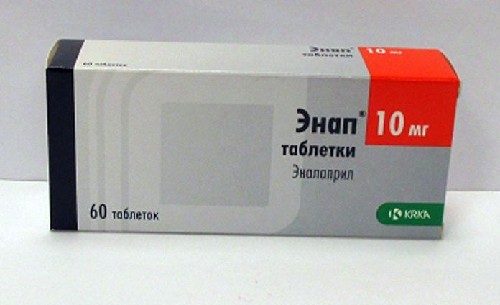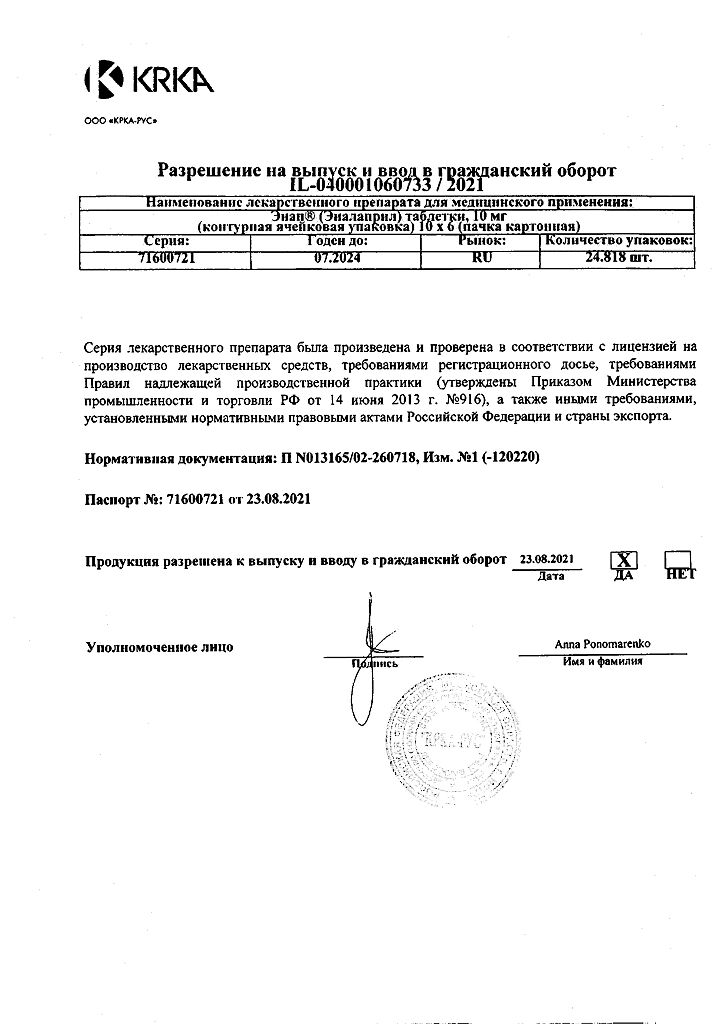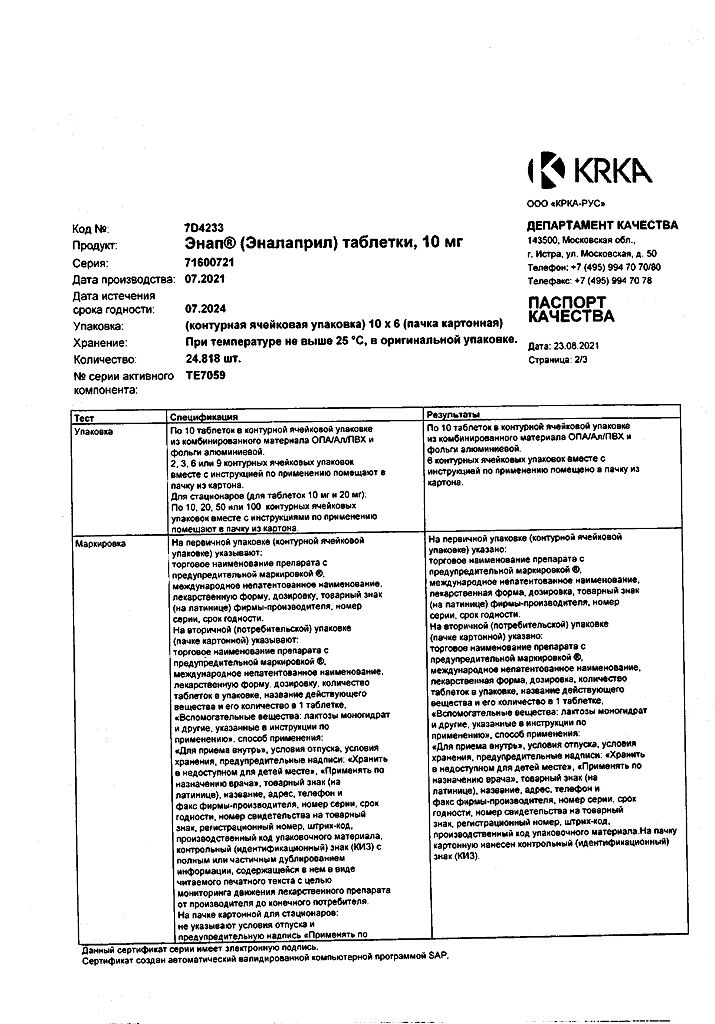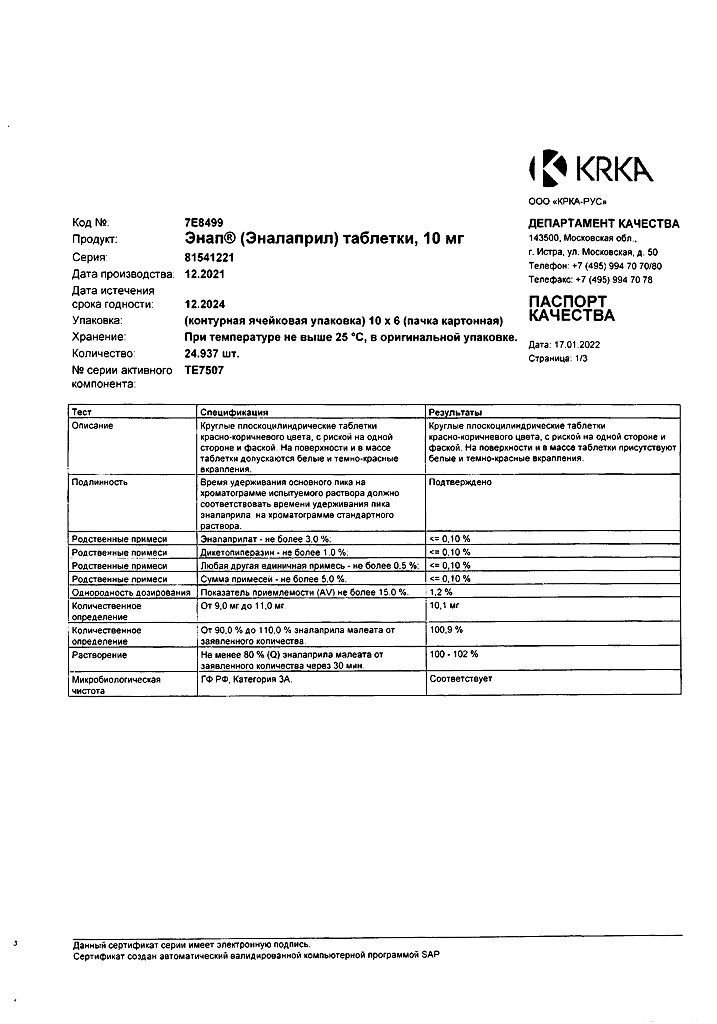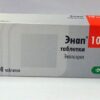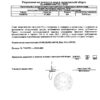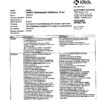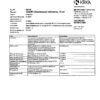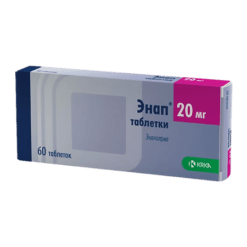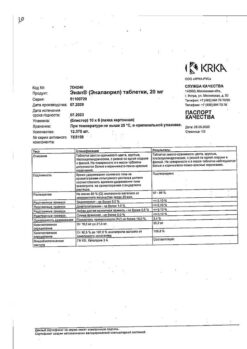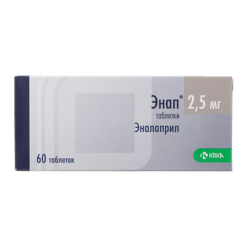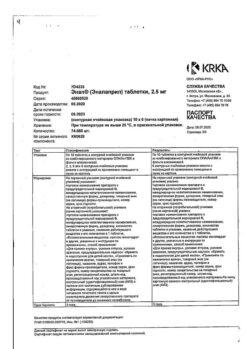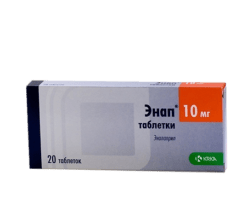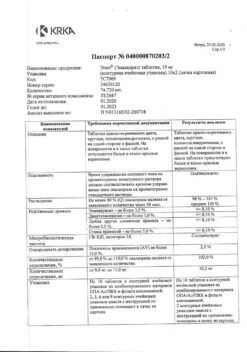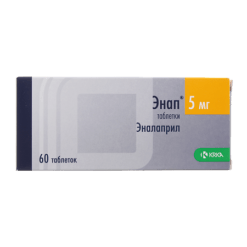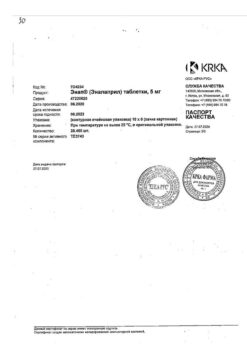No products in the cart.
Enap, tablets 10 mg 60 pcs
€6.61 €5.51
Description
Enap is an antihypertensive drug, an ACE inhibitor. Enalapril is a “prodrug”: as a result of its hydrolysis enalaprilate is formed. The mechanism of action is associated with inhibition of ACE activity under the influence of enalaprilat. This leads to a decrease in angiotensin II formation from angiotensin I, which causes a direct decrease in aldosterone secretion. As a result, there is a decrease in RPS, systolic and diastolic BP, post- and preload on the myocardium.
Dilates arteries to a greater extent than veins, and there is no reflex increase in HR.
Decreases bradykinin degradation and increases prostaglandin synthesis.
The antihypertensive effect is more pronounced at high plasma renin levels than at normal or reduced levels. Reduction of BP within therapeutic limits has no effect on cerebral blood flow. Blood flow in the cerebral vessels is maintained at a sufficient level even against the background of reduced BP. It increases coronary and renal blood flow.
Long-term use reduces hypertrophy of the left ventricular myocardium and myocytes of the walls of the resistive arteries, prevents the progression of heart failure and slows the development of dilatation of the left ventricle. It improves the blood supply to the ischemic myocardium.
Limits platelet aggregation.
Has some diuretic effect.
When the drug is taken orally the hypotensive effect develops in 1 hour, reaches a maximum after 4-6 hours and lasts up to 24 hours. In some patients, therapy for several weeks is necessary to achieve optimal BP level. In cardiac insufficiency, a marked clinical effect is observed with long-term use of 6 months or more.
.
Indications
Indications
— arterial hypertension;
— chronic heart failure (as part of combination therapy);
— prevention of the development of clinically significant heart failure in patients with asymptomatic dysfunction of the left ventricle (as part of combination therapy).
Pharmacological effect
Pharmacological effect
Enap is an antihypertensive drug, an ACE inhibitor. Enalapril is a “prodrug”: as a result of its hydrolysis, enalaprilat is formed. The mechanism of action is associated with inhibition of ACE activity under the influence of enalaprilat. This leads to a decrease in the formation of angiotensin II from angiotensin I, which causes a direct decrease in aldosterone secretion. As a result, there is a decrease in peripheral vascular resistance, a decrease in systolic and diastolic blood pressure, and post- and preload on the myocardium.
It dilates arteries to a greater extent than veins, but there is no reflex increase in heart rate.
Reduces the degradation of bradykinin, increases the synthesis of prostaglandins.
The antihypertensive effect is more pronounced with high plasma renin levels than with normal or reduced levels. Reducing blood pressure within therapeutic limits does not affect cerebral circulation. Blood flow in the vessels of the brain is maintained at a sufficient level and against the background of reduced blood pressure. Strengthens coronary and renal blood flow.
With long-term use, it reduces hypertrophy of the left ventricle of the myocardium and myocytes of the walls of resistive arteries, prevents the progression of heart failure and slows down the development of left ventricular dilatation. Improves blood supply to ischemic myocardium.
Reduces platelet aggregation.
Has some diuretic effect.
When taking the drug orally, the hypotensive effect develops after 1 hour, reaches a maximum after 4-6 hours and lasts up to 24 hours. In some patients, therapy is necessary for several weeks to achieve optimal blood pressure levels. In heart failure, a noticeable clinical effect is observed with long-term use – 6 months or more.
Special instructions
Special instructions
Arterial hypotension
If arterial hypotension occurs, it is necessary to place the patient on his back with a low head and, if necessary, adjust the volume of blood volume by infusion of a solution of 0.9% sodium chloride. Arterial hypotension that occurs after taking the first dose is not a contraindication for further treatment.
Caution is required in patients with coronary artery disease, severe cerebrovascular diseases, aortic stenosis or idiopathic hypertrophic obstructive subaortic stenosis, obstructing the outflow of blood from the left ventricle, severe atherosclerosis, in elderly patients, because there is a risk of developing arterial hypotension and deterioration of blood supply to the heart, brain and kidneys.
Potassium-sparing diuretics and potassium supplements
The simultaneous use of Enap® and potassium-sparing diuretics, as well as potassium preparations and potassium-containing salt substitutes is not recommended.
Hemodialysis
Anaphylactic reactions have been reported in patients receiving ACE inhibitors during hemodialysis using high-flux membranes (eg, AN69®). Therefore, it is advisable to use a different type of membrane or use an antihypertensive drug of a different pharmacotherapeutic group.
Aortic and/or mitral valve stenosis/hypertrophic obstructive cardiomyopathy (HOCM)
Enap®, like other ACE inhibitors, should be used with extreme caution in patients with left ventricular outflow tract obstruction and should be avoided in cases of cardiogenic shock and hemodynamically significant left ventricular outflow tract obstruction.
Kidney transplantation
There is no experience with the use of Enap® in patients who have recently undergone kidney transplantation.
Water-electrolyte imbalance
Regular monitoring of serum electrolyte concentrations during treatment is necessary to identify possible disturbances in water-electrolyte metabolism and timely take the necessary measures. Determination of serum electrolyte concentrations is mandatory for patients with prolonged diarrhea and vomiting.
In patients receiving Enap®, it is necessary to identify signs of water and electrolyte imbalance, such as dryness of the oral mucosa, thirst, weakness, drowsiness, increased excitability, myalgia and cramps (mainly of the calf muscles), decreased blood pressure, tachycardia, oliguria, as well as nausea and vomiting.
Allergic reactions/angioedema
If angioedema of the face occurs, it is usually sufficient to discontinue therapy and prescribe antihistamines to the patient. Angioedema of the tongue, pharynx or larynx can be fatal. In case of angioedema of the tongue, pharynx or larynx, which can lead to airway obstruction, it is necessary to immediately administer 0.3-0.5 ml of epinephrine (adrenaline) solution subcutaneously in a ratio of 1:1000 and maintain airway patency (intubation or tracheostomy).
Among black patients receiving ACE inhibitor therapy, the incidence of angioedema is higher than among patients of other races.
Patients with a history of angioedema not associated with ACE inhibitors are at increased risk of developing angioedema when taking any ACE inhibitor.
Due to the increased risk of anaphylactic reactions, Enap® should not be prescribed to patients undergoing hemodialysis using high-flow polyacrylonitrile membranes (AN 69®), undergoing LDL apheresis with dextran sulfate and immediately before the desensitization procedure with hymenoptera venom.
Surgery/general anesthesia
Before surgery (including in dentistry), it is necessary to warn the surgeon/anesthesiologist about the use of ACE inhibitors.
During surgery or during general anesthesia with the use of drugs that cause arterial hypotension, ACE inhibitors may block the formation of angiotensin II in response to compensatory release of renin. If a pronounced decrease in blood pressure develops due to a similar mechanism, it can be corrected by increasing the volume of blood volume.
Liver failure
In rare cases, during the use of ACE inhibitors, cholestatic jaundice occurs, with the progression of which fulminant liver necrosis develops, sometimes with a fatal outcome. If jaundice or a significant increase in the activity of hepatic transaminases occurs during the use of ACE inhibitors, the use of Enap® should be discontinued.
Neutropenia/agranulocytosis
Cases of neutropenia/agranulocytosis, thrombocytopenia and anemia have been reported in patients taking ACE inhibitors. In patients with normal renal function in the absence of other complications, neutropenia rarely develops. Enap® should be used with great caution in patients with connective tissue diseases (including systemic lupus erythematosus, scleroderma) who are simultaneously receiving immunosuppressive therapy, allopurinol or procainamide, as well as a combination of these factors, especially with existing renal dysfunction. These patients may develop severe infections that do not respond to intensive antibiotic therapy. If patients still take Enap®, it is recommended to periodically monitor the number of leukocytes in the blood.
The patient should be warned that if any signs of infection appear, they should immediately consult a doctor.
Patients with diabetes mellitus
When using the drug Enap® in patients with diabetes mellitus receiving oral hypoglycemic agents or insulin, during the first month of therapy it is necessary to regularly monitor the concentration of glucose in the blood.
Lithium
The simultaneous use of lithium and Enap® is not recommended.
Hyperkalemia
Hyperkalemia may develop during treatment with ACE inhibitors, incl. and enalapril. Risk factors for hyperkalemia are renal failure, old age, diabetes mellitus, some concomitant conditions (decrease in blood volume, acute heart failure in the stage of decompensation, metabolic acidosis), simultaneous use of potassium-sparing diuretics (such as spironolactone, eplerenone, triamterene, amiloride), as well as potassium preparations or potassium-containing substitutes table salt and the use of other drugs that increase the potassium content in the blood plasma (for example, heparin). Hyperkalemia can cause serious heart rhythm problems, sometimes fatal. The combined use of the above drugs should be carried out with caution.
Cough
When using the drug Enap®, a dry, prolonged cough may occur, which disappears after stopping the use of ACE inhibitors, which must be taken into account in the differential diagnosis of cough during the use of an ACE inhibitor.
Ethnic characteristics
Enap®, like other ACE inhibitors, has a less pronounced antihypertensive effect in patients of the Negroid race compared to representatives of other races.
Impact on the ability to drive vehicles and operate machinery
When using the drug Enap®, care must be taken when driving vehicles and engaging in other potentially hazardous activities that require increased concentration and speed of psychomotor reactions.
Active ingredient
Active ingredient
Enalapril
Composition
Composition
1 tab. contains:
Active substances:
enalapril maleate 10 mg.
Excipients:
sodium bicarbonate – 5.1 mg,
lactose monohydrate – 124.6 mg,
corn starch – 21.4 mg,
talc – 6 mg,
magnesium stearate – 1.7 mg,
red iron oxide dye (E172) – 1.2 mg.
Contraindications
Contraindications
– hereditary angioedema or idiopathic angioedema;
– history of angioedema associated with the use of ACE inhibitors;
– porphyria;
— pregnancy;
– lactation (breastfeeding);
– age under 18 years (efficacy and safety have not been established);
– lactose intolerance, lactase deficiency, glucose-galactose malabsorption syndrome;
– hypersensitivity to enalapril and other components of the drug Enap;
– increased sensitivity to other ACE inhibitors.
The drug should be used with caution in patients with bilateral renal artery stenosis or stenosis of the artery of a single kidney, with primary hyperaldosteronism, hyperkalemia, after kidney transplantation, with aortic stenosis and/or mitral stenosis (with hemodynamic disorders), hypertrophic obstructive cardiomyopathy, conditions with reduced BCC, with systemic connective tissue diseases (including scleroderma, systemic lupus erythematosus), ischemic heart disease, with suppression of bone marrow hematopoiesis, cerebrovascular diseases (including cerebrovascular insufficiency), diabetes mellitus, renal failure (proteinuria – more than 1 g/day), liver failure, in patients on a salt-restricted diet or on hemodialysis; simultaneously with immunosuppressants and saluretics; in elderly patients (over 65 years old).
Side Effects
Side Effects
Classification of the incidence of side effects (WHO): very often {> 1/10), often (> 1/100 and 1/1000 and 1/10,000 and <1/1000), very rarely (< 1/10,000), including isolated reports.
From the hematopoietic system: rarely – neutropenia, decreased hemoglobin and hematocrit, thrombocytopenia, agranulocytosis, inhibition of bone marrow hematopoiesis, pancytopenia, lymphadenopathy, autoimmune diseases; very rarely – anemia (including aplastic and hemolytic).
From the side of metabolism: infrequently – exacerbation of gout, hypoglycemia.
From the nervous system: very often – dizziness, weakness; often – headache, asthenia, depression; infrequently – insomnia, drowsiness, paresthesia, increased excitability; rarely – unusual dreams, sleep disturbances; very rarely – confusion, insomnia.
From the senses: often – changes in taste; infrequently – tinnitus, blurred vision.
From the cardiovascular system: often – marked decrease in blood pressure, orthostatic hypotension, fainting, chest pain, cardiac arrhythmias (atrial brady- or tachycardia, atrial fibrillation), tachycardia, angina pectoris; infrequently – palpitations, myocardial infarction or stroke (due to a pronounced decrease in blood pressure); rarely – thromboembolism of a branch of the pulmonary artery, Raynaud’s syndrome.
From the respiratory system: very often – cough; often – shortness of breath; infrequently – rhinorrhea, sore throat and hoarseness, bronchospasm; rarely – infiltrates in the lungs, rhinitis, allergic alveolitis/eosinophilic pneumonia.
From the digestive system: very often – nausea; often – diarrhea, abdominal pain, flatulence; uncommon – ileitis, intestinal obstruction, pancreatitis, vomiting, constipation, anorexia, dry oral mucosa, peptic ulcer; rarely – impaired liver function and bile secretion, hepatitis (hepatocellular or cholestatic), cholestatic jaundice, fulminant liver necrosis, stomatitis/aphthous ulcers, glossitis; very rarely – intestinal angioedema.
From the skin: often – skin rash; uncommon – exudative erythema multiforme, exfoliative dermatitis, toxic epidermal necrolysis, pemphigus, erythroderma, profuse sweating, itching, urticaria, alopecia, photosensitivity.
From the urinary system: infrequently – impaired renal function, acute renal failure; rarely – oliguria.
From the reproductive system: infrequently – decreased potency, decreased libido; rarely – gynecomastia.
From the musculoskeletal system: often – muscle spasms; infrequently – arthralgia.
From laboratory parameters: often – hyperkalemia, increased concentration of creatinine in the blood serum; uncommon – hyperglycemia, hyperuricemia, hypokalemia, hyponagriemia, increased urea concentration in the blood serum; rarely – increased activity of liver transaminases and bilirubin concentration.
Allergic reactions: uncommon – Stevens-Johnson syndrome; rarely – angioedema of the face, lips, tongue, pharynx, larynx, extremities.
Other: a symptom complex has been described that may include fever, myalgia and arthralgia, serositis, vasculitis, increased erythrocyte sedimentation rate, leukocytosis and eosinophilia, skin rash, positive test for antinuclear antibodies. A symptom complex has also been described, which includes facial skin flushing, nausea, vomiting and arterial hypotension and can develop with the simultaneous use of ACE inhibitors and gold preparations (sodium aurothiomalate) intravenously.
Interaction
Interaction
The simultaneous use of enalapril and potassium-sparing diuretics (such as spironolactone, eplerenone, triamterene, amiloride), potassium supplements or potassium-containing salt substitutes, as well as the use of other drugs that increase the level of potassium in the blood plasma (for example, heparin).
Tricyclic antidepressants and antipsychotics (neuroleptics) enhance the antihypertensive effect and increase the risk of developing orthostatic hypotension (additive effect).
The use of diuretics in high doses can lead to hypovolemia (due to a decrease in blood volume), and the addition of enalapril to therapy can lead to a pronounced decrease in blood pressure.
With simultaneous use of enalapril with lithium preparations, the excretion of lithium is slowed down (increased cardiotoxic and neurotoxic effects of lithium). Monitoring of lithium concentration in blood plasma is necessary.
The simultaneous use of enalapril and beta-blockers, alpha-blockers, ganglion blocking agents, methyldopa or slow calcium channel blockers can further reduce blood pressure.
Concomitant use of other antihypertensive drugs with ACE inhibitors may increase the risk of developing leukopenia.
Concomitant use of other antihypertensive drugs with ACE inhibitors may increase the risk of developing hyperkalemia.
Concomitant use of NSAIDs (including selective COX-2 inhibitors) may weaken the antihypertensive effect of ACE inhibitors.
NSAIDs and ACE inhibitors have an additive effect on increasing serum potassium, which may lead to a deterioration of renal function, especially in patients with impaired renal function. This effect is reversible.
Antacids may reduce the bioavailability of ACE inhibitors.
Sympathomimetics may reduce the hypotensive effect of ACE inhibitors.
Epidemiological studies suggest that the simultaneous use of ACE inhibitors and hypoglycemic agents may lead to the development of hypoglycemia. More often, hypoglycemia develops in the first weeks of therapy in patients with impaired renal function. Long-term and controlled clinical studies of enalapril do not confirm these data and do not limit the use of enalapril in patients with diabetes mellitus. However, such patients should be under regular medical supervision.
With the simultaneous use of ACE inhibitors and gold preparations (sodium aurothiomalate) intravenously, a symptom complex has been described, including facial flushing, nausea, vomiting and arterial hypotension.
Ethanol may enhance the antihypertensive effect of ACE inhibitors.
Enalapril can be used simultaneously with acetylsalicylic acid (as an antiplatelet agent), thrombolytics and beta-blockers.
Weakens the effect of medications containing theophylline.
Overdose
Overdose
Symptoms: pronounced decrease in blood pressure up to the development of collapse, myocardial infarction, acute cerebrovascular accident or thromboembolic complications, convulsions, stupor.
Treatment: the patient should be placed in a horizontal position with a low headboard. In mild cases, gastric lavage and ingestion of activated carbon are indicated; in more serious cases – measures aimed at normalizing blood pressure, intravenous administration of 0.9% sodium chloride solution, plasma expanders, if necessary – intravenous administration of angiotensin II, hemodialysis (enalaprilat excretion rate – 62 ml/min).
Manufacturer
Manufacturer
KRKA dd Novo Mesto, Slovenia
Additional information
| Manufacturer | KRKA dd Novo mesto, Slovenia |
|---|---|
| Medication form | pills |
| Brand | KRKA dd Novo mesto |
Other forms…
Related products
Buy Enap, tablets 10 mg 60 pcs with delivery to USA, UK, Europe and over 120 other countries.

